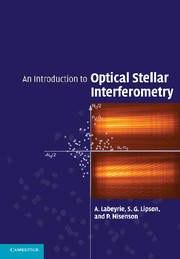Book contents
- Frontmatter
- Contents
- List of Illustrations
- Preface
- Peter Nisenson, 1941–2004
- 1 Introduction
- 2 Basic concepts: a qualitative introduction
- 3 Interference, diffraction and coherence
- 4 Aperture synthesis
- 5 Optical effects of the atmosphere
- 6 Single-aperture techniques
- 7 Intensity interferometry
- 8 Amplitude interferometry: techniques and instruments
- 9 The hypertelescope
- 10 Nulling and coronagraphy
- 11 A sampling of interferometric science
- 12 Future ground and space projects
- Appendix A
- Appendix B
- Index
6 - Single-aperture techniques
Published online by Cambridge University Press: 23 February 2010
- Frontmatter
- Contents
- List of Illustrations
- Preface
- Peter Nisenson, 1941–2004
- 1 Introduction
- 2 Basic concepts: a qualitative introduction
- 3 Interference, diffraction and coherence
- 4 Aperture synthesis
- 5 Optical effects of the atmosphere
- 6 Single-aperture techniques
- 7 Intensity interferometry
- 8 Amplitude interferometry: techniques and instruments
- 9 The hypertelescope
- 10 Nulling and coronagraphy
- 11 A sampling of interferometric science
- 12 Future ground and space projects
- Appendix A
- Appendix B
- Index
Summary
Introduction
We saw in the chapter on atmospheric turbulence that the real limitation to the resolution of a ground-based telescope is not the diameter of the telescope aperture, but the atmosphere. As a result, a telescope of any diameter will rarely give an angular resolution in visible light better than 1 arcsec, which is equivalent to the diffraction limit of an aperture of about 10 cm diameter (the Fried parameter, r0, defined in section 5.4.1). This limitation has been considered so fundamental that large telescope mirrors might not even have been polished to an accuracy which could give a better resolution than this. The ideas behind the various methods of astronomical interferometry are all directed at exceeding it.
The first idea was due to Fizeau (1868) who conceived the idea of masking the aperture of a large telescope with a mask containing two apertures each having diameter less than r0, but separated by a distance considerably greater than this. The result would be to modulate the image with Young's fringes and, from the contrast of the fringes, to glean information about the source dimensions. A few years after the publication of Fizeau's idea, Stéphan (1874) tried it out experimentally with the 1-m telescope at Marseilles and concluded (correctly) that the fixed stars were too small for their structure to be resolved by this telescope. Michelson (1891) later developed the necessary theory to make this idea quantitative and was the first to succeed in using Fizeau's technique, when he measured the diameters of the moons of Jupiter using the 12-inch Lick refractor telescope.
- Type
- Chapter
- Information
- An Introduction to Optical Stellar Interferometry , pp. 120 - 140Publisher: Cambridge University PressPrint publication year: 2006

